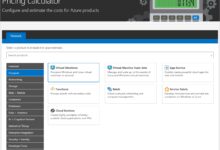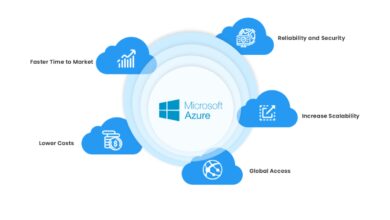Azure Cost Calculator: 7 Powerful Ways to Master Cloud Spending
Managing cloud costs doesn’t have to feel like navigating a maze. With the Azure Cost Calculator, you gain real-time insights, accurate forecasting, and full control over your Microsoft Azure spending—all in one intuitive tool.
What Is the Azure Cost Calculator and Why It Matters

The Azure Cost Calculator is an essential online tool provided by Microsoft to help businesses, developers, and IT managers estimate the costs of using Azure cloud services before deployment. Whether you’re planning a small web app or a large-scale enterprise infrastructure, this calculator allows you to model your ideal setup and receive a detailed cost breakdown.
How the Azure Cost Calculator Works
The tool operates on a modular, service-based selection system. Users can pick specific Azure resources—like virtual machines, databases, storage, networking, and AI services—and configure them based on region, performance tier, usage hours, and data transfer needs. As you add and adjust components, the calculator dynamically updates the estimated monthly or annual cost.
- Users select services from a comprehensive catalog.
- Each service can be customized with real-world parameters (e.g., VM size, storage type).
- The tool aggregates costs and displays them in a clear summary.
This real-time feedback loop empowers teams to make informed decisions before committing to actual cloud spend. Unlike rough estimates or third-party tools, the Azure Cost Calculator pulls pricing data directly from Microsoft’s official rate cards, ensuring accuracy and reliability.
Key Benefits for Businesses and IT Teams
One of the biggest advantages of the Azure Cost Calculator is its ability to prevent budget overruns. By simulating different deployment scenarios, organizations can compare costs between various architectures—such as using reserved instances versus pay-as-you-go models.
- Enables cost comparison across service tiers and regions.
- Supports financial planning and cloud budget approvals.
- Reduces surprises in billing by setting realistic expectations.
For example, a company considering migrating from on-premises servers to Azure can use the calculator to estimate the total cost of ownership (TCO), including compute, backup, networking, and management tools. This transparency builds trust between technical teams and finance departments.
“The Azure Cost Calculator is not just a pricing tool—it’s a strategic planning asset that bridges the gap between technical design and financial accountability.” — Microsoft Azure Documentation
Step-by-Step Guide to Using the Azure Cost Calculator
Getting started with the Azure Cost Calculator is simple, but mastering it requires understanding its full capabilities. Below is a detailed walkthrough of how to use the tool effectively to generate accurate and actionable cost estimates.
Step 1: Access the Tool and Create a New Estimate
Visit the official Azure Pricing Calculator page. No login is required to begin, though signing in with a Microsoft account allows you to save your estimates for future reference.
- Click “Create a new estimate” to start fresh.
- You can name your project (e.g., “Production Web App Migration”) for easy organization.
- The interface opens with a blank canvas where you’ll add services.
This initial step sets the foundation for your cost modeling. Naming your estimate properly helps when managing multiple projects or comparing different deployment strategies.
Step 2: Add and Configure Azure Services
Use the search bar or browse categories to find the services you plan to use. Common categories include Compute, Storage, Networking, Databases, AI + Machine Learning, and Developer Tools.
- Select a service (e.g., Virtual Machines) and configure its specifications.
- Choose region, instance size, OS type, and estimated usage (e.g., 720 hours/month for continuous operation).
- Add multiple instances if needed (e.g., 3 VMs for high availability).
For storage, you can specify the type (Standard HDD, SSD, Premium), redundancy (LRS, ZRS, GRS), and total capacity in GB or TB. Each selection updates the cost in real time, helping you visualize the financial impact of technical decisions.
Step 3: Review, Export, and Share Your Estimate
Once all services are added, the calculator displays a summary of your total estimated monthly cost. You can break down costs by service, view tax estimates (if applicable), and apply discounts like Azure Hybrid Benefit or Reserved Instances.
- Click “Download” to export the estimate as a CSV or PDF file.
- Share the link with stakeholders for collaboration.
- Save the estimate to your Microsoft account for future editing.
This step is crucial for cross-team alignment. Finance teams can use the exported report for budgeting, while architects can refine the design based on cost feedback.
Key Features That Make the Azure Cost Calculator Powerful
The Azure Cost Calculator stands out from generic pricing tools due to its depth, integration with real Azure services, and support for advanced cost optimization strategies. Let’s explore the features that make it a must-use for any Azure planning process.
Real-Time Pricing with Regional Variability
One of the most powerful aspects of the Azure Cost Calculator is its ability to reflect pricing differences across global regions. For example, running a D4s v3 virtual machine in East US might cost $0.192/hour, while the same instance in North Europe could be $0.212/hour.
- Users can switch regions instantly to compare costs.
- Regional pricing includes variations in data transfer, egress fees, and service availability.
- This helps organizations choose the most cost-effective location for deployment.
For multinational companies, this feature supports strategic decisions about where to host workloads based on both performance and cost.
Support for Reserved Instances and Savings Plans
The calculator allows users to model the financial impact of committing to one- or three-year terms through Azure Reserved VM Instances or Compute Savings Plans. These options can reduce compute costs by up to 72% compared to pay-as-you-go pricing.
- Toggle the reservation option to see upfront and monthly payment estimates.
- Compare total cost of ownership between reserved and on-demand models.
- Factor in Azure Hybrid Benefit for Windows Server and SQL Server licenses.
This feature is especially valuable for predictable workloads like production databases or backend services that run continuously.
“By using the Azure Cost Calculator to model reserved instances, one enterprise reduced its annual compute spend by $180,000.” — Microsoft Customer Case Study
How the Azure Cost Calculator Compares to Other Tools
While several cloud cost estimation tools exist, the Azure Cost Calculator has distinct advantages—especially for organizations deeply invested in the Microsoft ecosystem. Let’s compare it with alternatives to understand its unique value.
Azure Cost Calculator vs. Third-Party Tools
Third-party tools like CloudHealth, ParkMyCloud, or Turbot offer multi-cloud cost management but often rely on estimated pricing models. In contrast, the Azure Cost Calculator uses real-time, official Microsoft pricing data.
- Third-party tools may lag in updating new Azure service prices.
- The official calculator includes early access to preview pricing and regional rollouts.
- It integrates seamlessly with Azure Advisor and Cost Management tools post-deployment.
For pure Azure environments, the official calculator is more accurate and up-to-date than most external solutions.
Azure Cost Calculator vs. AWS Pricing Calculator
Amazon Web Services offers a similar tool called the AWS Pricing Calculator. While both platforms provide detailed cost modeling, the Azure version excels in hybrid cloud scenarios and Windows-based workloads.
- Azure Hybrid Benefit is natively supported in the calculator, reducing Windows and SQL licensing costs.
- Better integration with on-premises systems via Azure Arc and Azure Stack.
- Simpler UI for users already familiar with the Azure portal.
For organizations with existing Microsoft licenses, the Azure Cost Calculator often reveals significant savings that AWS cannot match.
Common Mistakes When Using the Azure Cost Calculator
Even with a powerful tool like the Azure Cost Calculator, users can make errors that lead to inaccurate estimates. Avoiding these common pitfalls ensures your financial planning remains solid and reliable.
Underestimating Data Transfer and Egress Costs
One of the most frequent mistakes is ignoring data egress fees—charges for transferring data out of Azure to the internet or other regions. While inbound data is usually free, outbound traffic can add up quickly.
- Always include estimated egress volume (e.g., 5 TB/month for a public-facing app).
- Factor in cross-region replication or backup transfers.
- Use the calculator’s networking section to model these costs accurately.
For example, transferring 10 TB of data from East US to the internet costs approximately $90/month, which can be a hidden expense if not planned.
Overlooking Management and Monitoring Tools
Many users focus only on core services like VMs and storage but forget about operational tools such as Azure Monitor, Log Analytics, or Backup services.
- Azure Monitor charges based on data ingestion volume.
- Log Analytics workspaces have per-GB pricing.
- Automated backups for VMs or databases incur additional storage and transaction costs.
Always include monitoring and governance tools in your estimate to reflect real-world operational expenses.
Advanced Tips for Maximizing the Azure Cost Calculator
Once you’ve mastered the basics, you can leverage advanced techniques to get even more value from the Azure Cost Calculator. These strategies help optimize both cost and performance.
Use Scenarios to Compare Architectural Options
Create multiple estimates to compare different technical approaches. For example:
- Scenario A: Traditional three-tier architecture with VMs, SQL Database, and Application Gateway.
- Scenario B: Serverless architecture using Azure Functions, Cosmos DB, and Static Web Apps.
- Scenario C: Hybrid model with on-premises Active Directory and Azure-hosted apps.
By building side-by-side comparisons, you can present data-driven recommendations to stakeholders, showing not just cost differences but also scalability and maintenance implications.
Leverage the API for Automation and Integration
Microsoft provides a REST API for the Azure Pricing Calculator, allowing developers to integrate cost estimation into internal tools, CI/CD pipelines, or customer-facing portals.
- Automate cost reports for DevOps teams.
- Embed cost calculators into SaaS product dashboards.
- Trigger cost alerts when new services are proposed.
This level of automation ensures cost awareness is built into the development lifecycle, not just an afterthought.
Integrating the Azure Cost Calculator with Azure Cost Management
The Azure Cost Calculator is just the beginning. Once your resources are deployed, you need ongoing cost monitoring and optimization. This is where Azure Cost Management + Billing comes into play.
From Estimation to Real-Time Monitoring
Azure Cost Management allows you to track actual spending against your initial estimates from the calculator. You can set budgets, receive alerts, and analyze cost trends by service, department, or tag.
- Import tags from your calculator estimate (e.g., environment=production, department=marketing).
- Create custom views to monitor specific workloads.
- Use anomaly detection to spot unexpected cost spikes.
This integration closes the loop between planning and execution, ensuring financial accountability throughout the cloud lifecycle.
Optimizing Costs Post-Deployment
After deployment, Azure Cost Management can recommend cost-saving actions such as:
- Right-sizing underutilized VMs.
- Deleting unattached disks or unused public IPs.
- Purchasing reserved instances based on usage patterns.
These recommendations are based on actual telemetry data, making them highly actionable. By comparing these insights with your original Azure Cost Calculator estimate, you can refine future models for greater accuracy.
What is the Azure Cost Calculator?
The Azure Cost Calculator is a free online tool from Microsoft that helps users estimate the cost of Azure cloud services before deployment. It allows detailed configuration of resources like VMs, storage, and databases, providing real-time cost estimates based on region, usage, and service tier.
Is the Azure Cost Calculator accurate?
Yes, the Azure Cost Calculator uses real-time pricing data directly from Microsoft, making it one of the most accurate tools available for estimating Azure costs. However, actual bills may vary slightly due to usage fluctuations, taxes, or additional services not included in the estimate.
Can I save and share my cost estimates?
Yes, you can save your estimates by signing in with a Microsoft account. You can also download them as PDF or CSV files and share a link with team members or stakeholders for collaboration.
Does the Azure Cost Calculator include discounts?
Yes, it supports Azure Hybrid Benefit, Reserved Instances, and Enterprise Agreements. You can toggle these options to see how they reduce your total cost.
How does the Azure Cost Calculator help with budgeting?
It enables teams to model different scenarios, compare costs, and generate reports for financial planning. By setting realistic expectations upfront, it helps prevent budget overruns and supports cloud governance initiatives.
Mastering the Azure Cost Calculator is a critical step in achieving cloud financial management excellence. From initial planning to post-deployment optimization, this tool empowers organizations to make smarter, data-driven decisions. By avoiding common mistakes, leveraging advanced features, and integrating with Azure Cost Management, you can ensure your cloud journey is both innovative and fiscally responsible. Whether you’re a startup or a global enterprise, the Azure Cost Calculator is your first line of defense against unpredictable cloud bills.
Recommended for you 👇
Further Reading:









